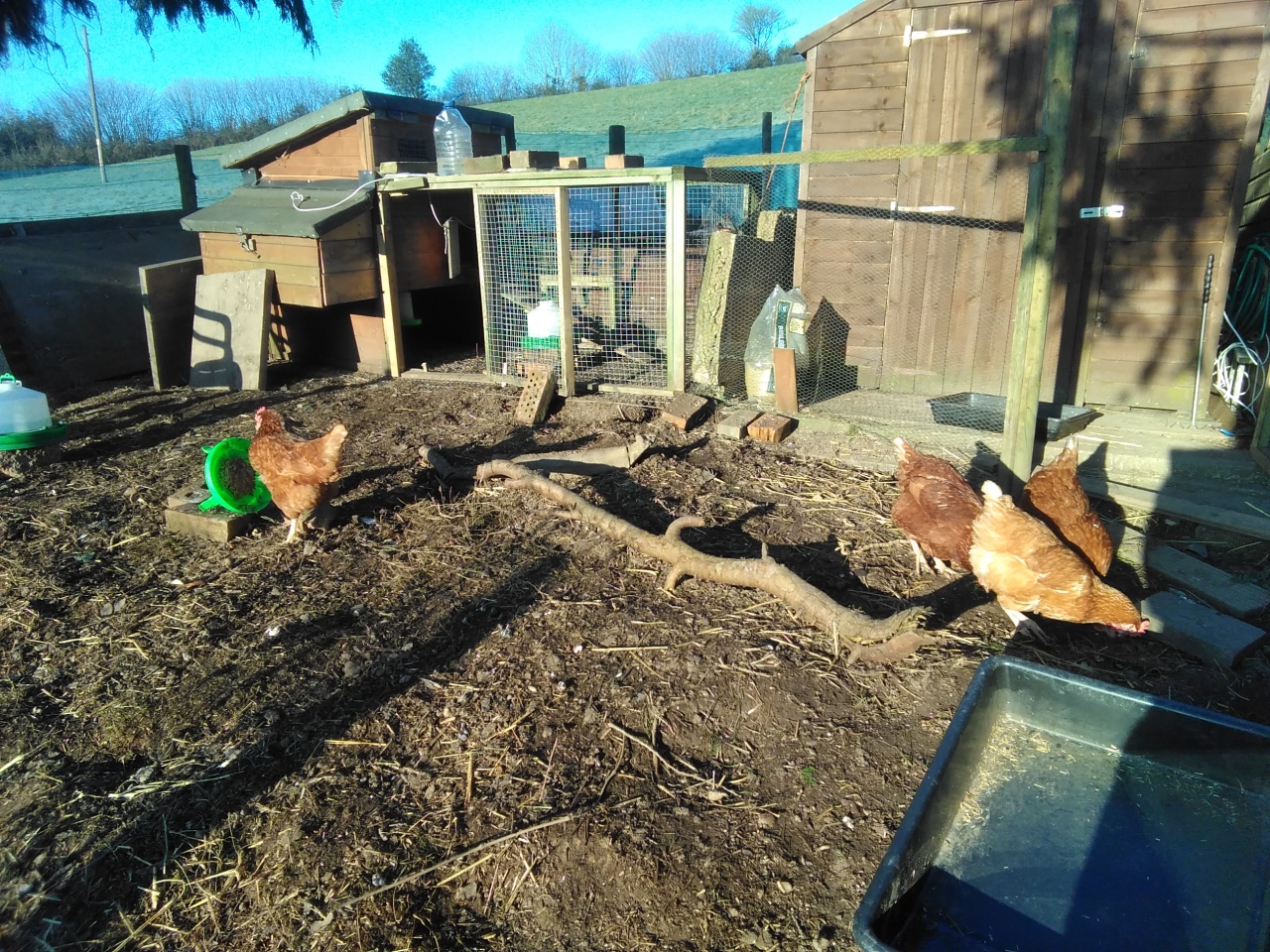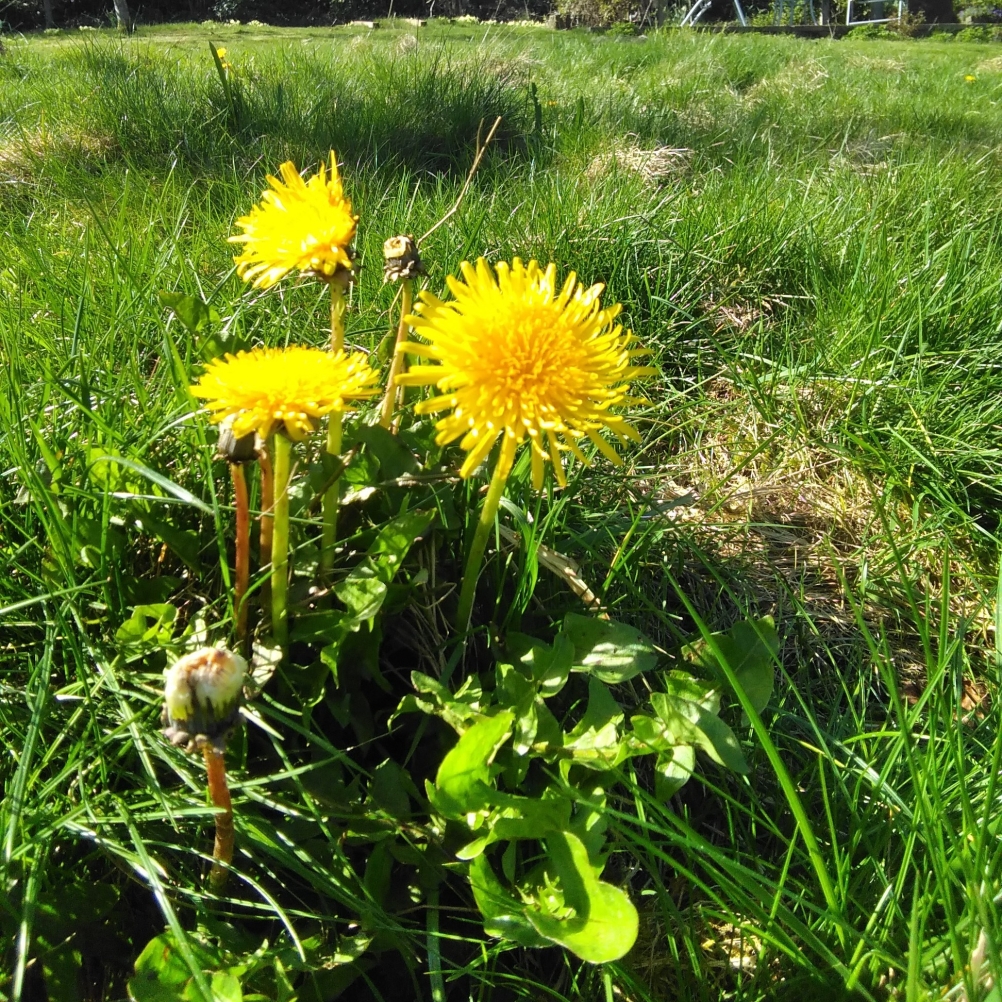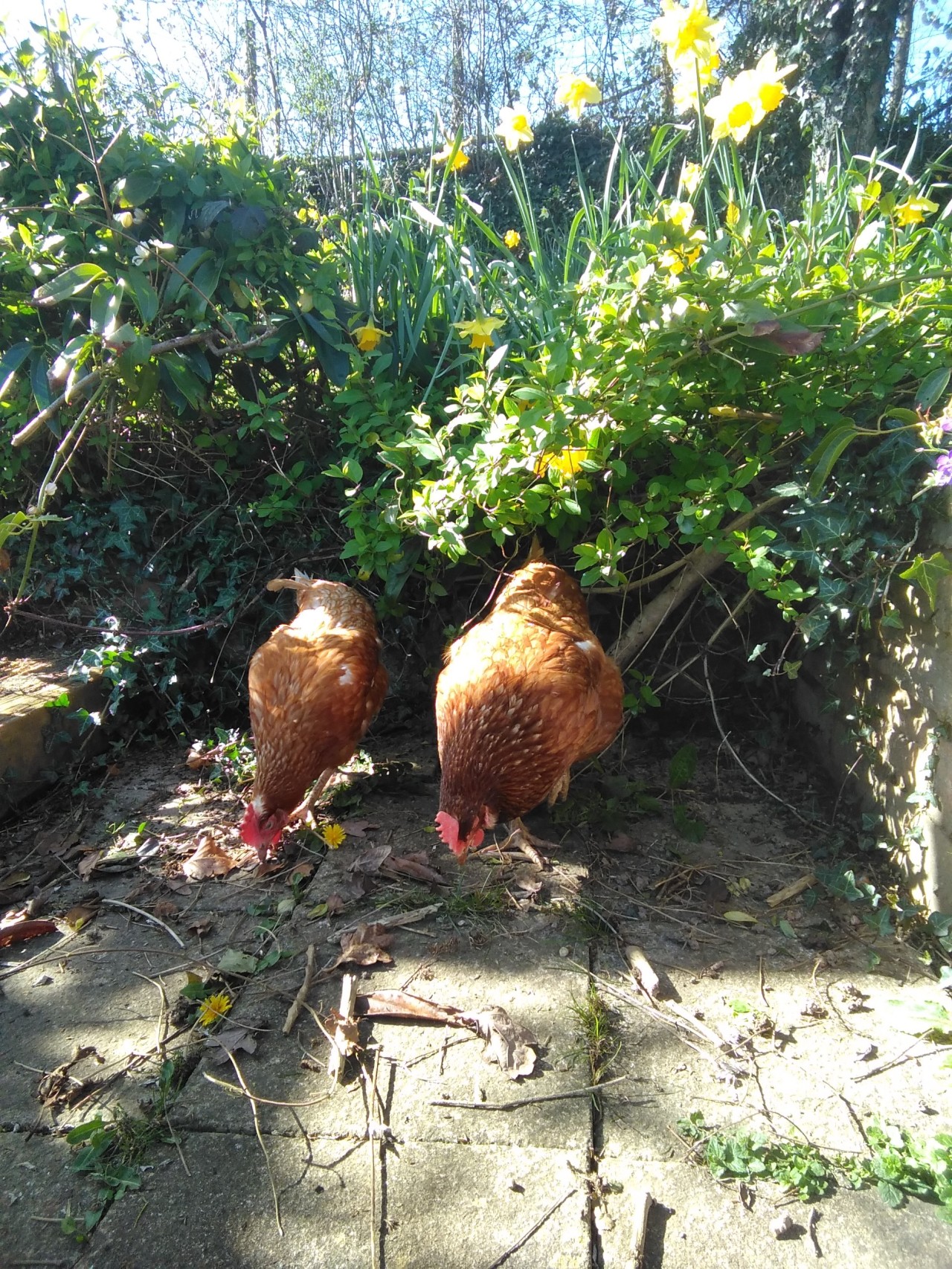Giver of Life, Help me help you share your gift. Amen.
The Birds

The Chickenarium in the morning
Well, Nutmeg has been acting up health wise and this has prompted a need for all four birds to be on antibiotics:
The birds seemed to cut back on food intake about two weeks ago, then egg production dropped from 4 to 3 a day. Somewhere in there Nutmeg developed a ‘dirty bum.’ Chickens are good at keeping their back ends free from faeces, so when they get ‘dirty’ it’s a sign something is not right. Nutmeg’s bum was dirty enough to earn her a bum bath in the old dish tub in the utility room: warm soapy water and a bit of swishing and gentle scrubbing with a cloth.
I did not give her a blow dry!
The next day after the bath she was droopy: head down, tail down, even wings hanging a bit. So off to the vet we went. The vet wasn’t certain but thought she might have a chronic respiratory infection that wasn’t showing, so she got an antibiotic injection, and at my request because Clover had woken up with a dirty bum, I was sent home with additional antibiotics to put in their water.
That was last week.
This week Nutmeg is looking better. Her comb colour is improving and her posture is better, and each day she has been more active than the day before. But she is sneezing again, so I need to check on that. Perhaps she does have a chronic respiratory condition.
As the weather is warmer and the rain has stopped we removed all of the winter weather-proofing to improve the ventilation in the run, and I have moved the food and water to a sheltered spot outside of the run, just in case the run has been damp enough to cause a problem.
Hopefully all of this will do the trick, but I am remembering now how much care rescue hens need compared to chickens who have not been used for commercial egg laying: at less than two years of age they are worn out, and this makes them vulnerable.
The Bees

Dandelions are one of the best early food sources for bees so DO NOT pick, mow, or dig up until later in the spring!
Bee Class is going pretty well. But…
During last week’s class – on hives – in which all of the seasoned beekeepers agreed that cedar hives are preferable to all others, I did ask about polystyrene hives.
‘You haven’t mentioned polystyrene hives this evening, or in last year’s class … so, what about polystyrene?’ The instructor fixed my gaze with his. ‘What about polystyrene?’
Which was about all I expected, really.
To be fair, the instructor did point out that he had one – right next to him on the floor, in fact. But because they are so lightweight the wind tends to wreck havoc with them if they are not weighted down properly, and as the recommended way of cleaning them between colonies is to submerge them in boiling water for 15 minutes (as opposed to scorching the wooden ones with a blow torch!), they may be impractical. Add to that their negative environmental impact and the fact that cedar hives may last in excess of 70 years…
All of the usual styles of wooden hives – National, Smith, etc. – now come in polystyrene as well. This means the frames that hold the honey and the brood can be used with either wooden or polystyrene hives.
So I am considering one of each. I could do my own comparison that way. But I haven’t decided.
Peer pressure is hell.
This week’s class was on The Beekeeping Year. We were taught about the yearly cycle of the colony and what care is required when.
Autumn seems to be the starting point as it is the time of year when most of the work has finished and the bees need to be bedded down for winter. Hive numbers begin to decrease from a maximum of 70,000 to 10,000 bees per colony, and it is these 10,000 worker bees who overwinter with the queen, keeping her alive until spring.
Things that will kill the bees, and are to be avoided, are damp and starvation. Damp is avoided by having adequate ventilation, and hives are designed to provide this. As long as the hive is sited well the only thing needed to keep it well ventilated is to remove any snow or ice that blocks the vents. Starvation is avoided by providing the bees with enough food to get through the winter. This food comes in the form of either a liquid or a solid which they access from inside the hive, thus never needing to go out in the cold weather.
It is important NOT to open the hive in winter because the hive will lose so much heat. It is imperative that the keeper puts a generous supply of food into the hive in the autumn so that the hive can be left closed until spring.
However, sometimes the food stores do need to be topped up. The way to figure this out without opening the hive is by ‘hefting’ it – lifting one corner – to see if its weight corresponds to the amount of food that should be in there. If it is too light the bees may have eaten more than expected, and they will need a food top up.
It is better to put ample amounts in in the autumn than top up in the winter. So, put in more than needed in the autumn.
If the hive must be opened in the winter to add food it is best to use the most concentrated form of sugar you can find. Fondant icing is the best because it has a very low water content. It provides all the energy without the hassle of frozen water. Liquid feed may freeze, and this creates the additional work of both thawing the water and evaporating the water before eating the sugar. All of this work is done with bee body heat. By beating their wings, their little wing muscles produce heat. This thaws the ice and, in time, causes the unneeded water to evaporate. To create this body heat the bees needs additional food which may already be in short supply as it is winter. Redirecting energy needed to keep the queen alive may cause the colony to starve and die.
As winter comes to an end and temperatures begin to warm, the bees come out and begin to forage. This is what they are supposed to do. But if there is a brief spell of warm weather followed by a cold snap it may cause problems: The bees will begin foraging before the early food supplies – particularly pollen – are available. This is what I was worrying about a few weeks ago when the I saw a few bees in the garden.
But good news! It was announced this week that the Exmoor apiaries were inspected for the first time this year and all was very well in the hives. Instead of finding starving bees, and they found queens busy laying eggs and glistening stores of nectar in the combs! So it looks like the colonies are a bit ahead of the curve. Well done, bees! And phew.
The hives will not be opened again until near the end of April, when we get consistently warm temperatures. The only thing the bees need in the early spring is to start increasing the size of the hive and the less we mess with them the better. But when the hives are opened again, it will be time for full observational checks – finding the queen, checking for eggs, larvae, capped cells, honey stores, nectar and pollen stores, and disease.
As the spring season progresses weekly checks for all of the above are necessary, along with any interventions that may be required.
Interventions include adding frames to hold brood (eggs and larvae) and honey, removing diseased frames or old dirty ones, treating for pests, and possibly removing excess honey stores. Some bee colonies do so well in the spring that keepers can do an early honey harvest.
Late spring brings one of the biggest risks: swarms. Swarms are a natural phenomenon. It is how colonies grow and reproduce themselves. Once a hive gets too full of bees the colony will begin preparations to swarm. This is best avoided.
Swarm class is next week so I will write more about how to prevent swarms next time.
After swarm season ends hives still need weekly checks to monitor food stores and reproduction rates. June can be a slow month for foraging as the spring blooms are coming to an end and the summer ones don’t really gear up until July. Colonies may need to be fed sugar solution in June. Come July the keepers main responsibilities are preventing/treating pest infestations and preparing to harvest honey that is EXCESS to the (winter) needs of the hive. More about this later.
Then, at the end of the summer, comes the collection of honey… which is our way of saying sneakily stealing it from the bees when they are not looking. Once the honey-filled combs are removed from the hives, the honey is extracted and the wax is melted down and cleaned for reuse – perhaps as candles or furniture polish, or perhaps to go back into a hive.
And, then you find yourself preparing the hive, once again for winter….
And so it goes: a time of preparing to rest, followed by rest, and then the busy time of new life. With a lot of worry about food all the way through.
Sounds a lot like any other form of life.

Ginger and Clover doing what they do best


Looking forward to some honey later in the year. The eggs were wonderful! Thank you.
LikeLiked by 1 person